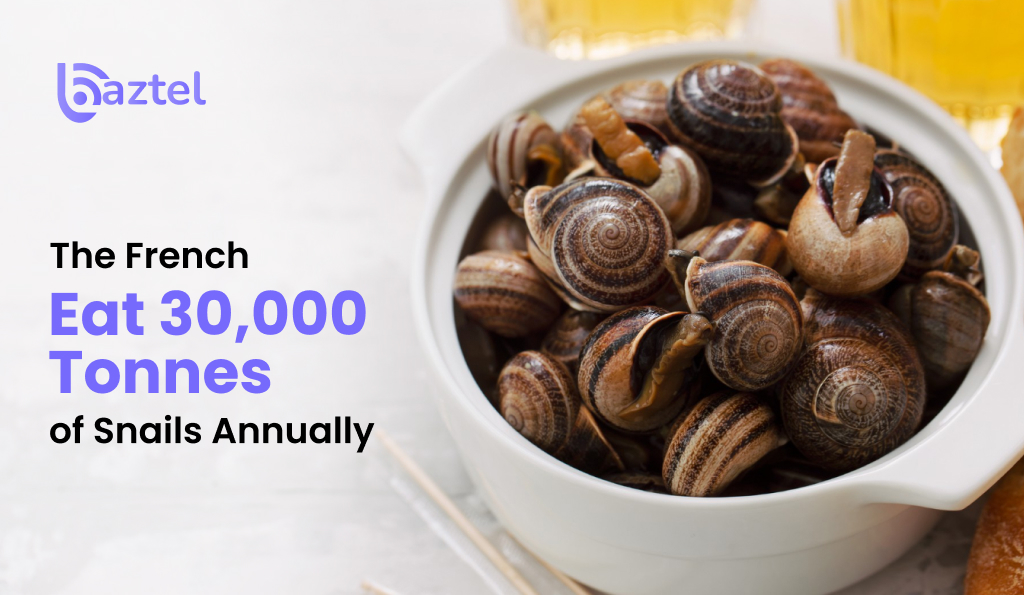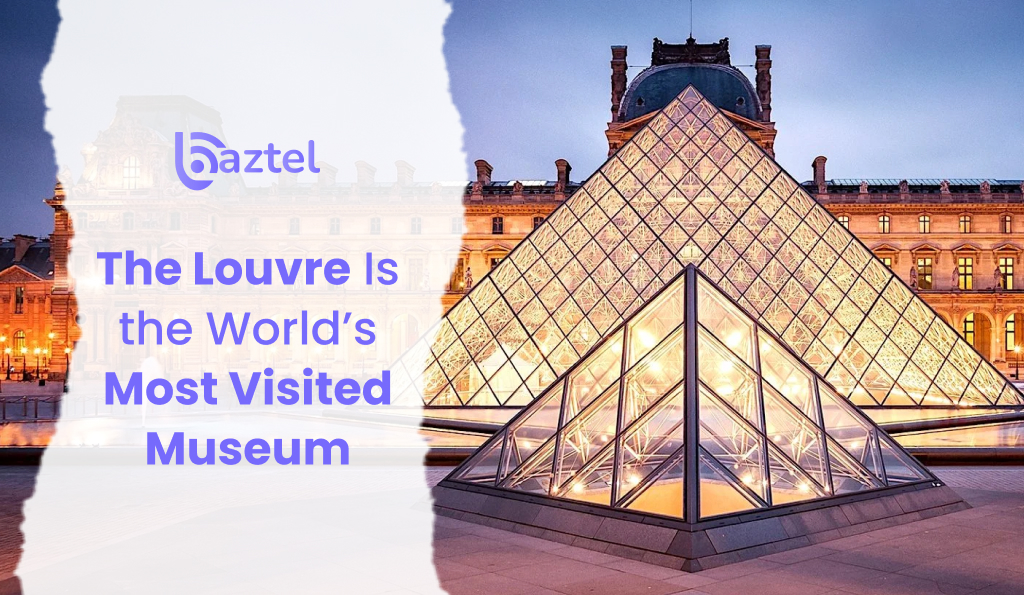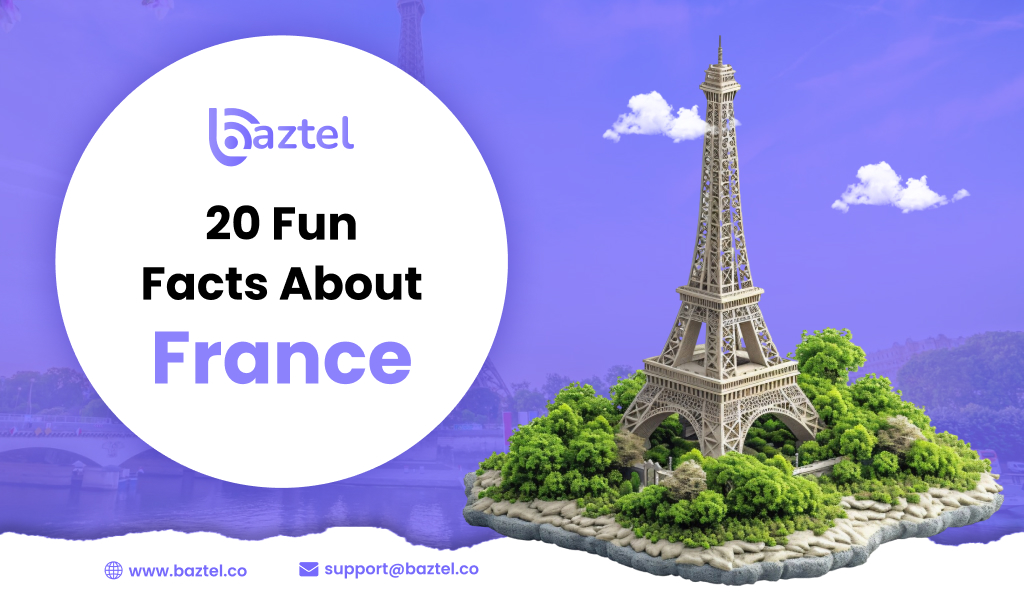France is a country that has kept the classic beauty along with the artistic and innovative expression; therefore, it is a place that attracts people for its culture, history, and beauty, besides the innovations that it has made. The romantic milieu of the country that gets reflected in the Paris streets, the aroma of lavender in Provence, the snow-capped Alps, the golden sandy shores of the Côte d’Azur, or French Riviera, and the like, France continues winning and overwhelming with its allure millions of tourists every year. Its various and highly praised gourmet food, universalized by the Eiffel Tower and cracking open the Louvre, quaint villages, the flow of the artist over time, and the warm culture of cafés make it one of the most loved places on Earth.
However, besides the main attractions, there is still a range of astonishing, sometimes surprising and even lesser-known facts that can tell us how special and extraordinary France indeed is. So, whether you’re the one who always wants to know more, the one who loves to travel, or just the one who is thinking about a future trip, these amusing facts will give you a whole new view of France.
This blog is going to take you through 20 fun facts about France, each of those thoroughly explained, then useful info about eSIM connectivity for travelers, and finally, the conclusion that pulls it all together and the five frequently asked questions that serve as the guide for your trip.
Top 20 Fun Facts About France
History, culture, art, food and innovation are some of the things that make France an incredible country. Ruins of ancient Rome, the Louvre, and the Eiffel Tower, along with the inventions and films, are just some instances of the profound impact that France has had on world culture. These 20 fun facts about France unfold the charm, uniqueness, and astonishing contributions of the country to the world.
1. France Is Nicknamed “L’Hexagone”

Due to its specific contour, France is frequently referred to as “L’Hexagone,” meaning the “six-sided figure.” This moniker represents the country’s character and it is used a lot by the people living there and also in educational institutions. It symbolizes unity, structure, and the unique placement of France within Europe. The shape also makes it easy to reference in geography discussions.
- Refers to mainland France
- Six-sided geographic shape
- Commonly taught in schools
- Used by locals casually
- Symbol of national unity
2. France Is the World’s Most Visited Country
France has been a top tourist destination for a long time, attracting over 80-90 million visitors every year. Attracting tourists to the country from the whole world is the wonderful mix of art, architecture, fashion, beaches, mountains, and cultural variety. Paris, the best tourist city globally, is recognized for love, art and luxury in daily life.
Key Points:
- Over 80+ million visitors yearly
- Paris is the top attraction
- Strong cultural reputation
- Attractions for all seasons
- Global tourism leader
3. France Has 45 UNESCO World Heritage Sites
In France, you can marry someone even after they’ve died, as long as both of you planned to get married before they passed. It’s rare, and honestly, it’s not easy. You have to pull together a mountain of documents and convince the president to approve it. But for people who’ve lost someone they love, this law really matters. It’s messy, sure, but it means a lot to those left behind.
- Mix of cultural and natural sites
- Includes iconic landmarks
- Strict preservation rules
- Globally recognized heritage
- Diverse historical periods represented
4. The French Eat 30,000 Tonnes of Snails Annually

For the French, escargots are still the top delicacy, and domestic consumption is around 30,000 tons annually. Snails cooked in a mixture of garlic, herbs, and butter are still seen as the main part of the French culinary art and they have a cultural value. They express the boldness and variety of French cuisine, being usually served in the course of celebrations, holidays, and special events.
- Traditional French delicacy
- Cooked with garlic butter
- Popular during holidays
- Often farm-raised
- Almost entirely consumed locally
5. The Eiffel Tower Was Almost Temporary
Built for the 1889 World’s Fair, the Eiffel Tower was originally intended to stand for only 20 years. Its value in telecommunications saved it from demolition. Today, it symbolizes France and attracts millions annually, proving how a temporary structure became one of the world’s most iconic landmarks.
- Built for 1889 exposition
- Designed by Gustave Eiffel
- Saved due to radio use
- Global cultural symbol
- Attracts millions yearly
6. France Produces Over 1,000 Cheeses

France is a cheese lover’s dream, producing more than 1,000 varieties ranging from soft and creamy to strong and aged. Each region offers its own specialty, many protected by AOC laws. Cheese plays an essential role in French cuisine and culture, often featured in daily meals and celebrations.
- 1,000+ varieties
- Regional specialties
- Protected by AOC status
- Cultural significance
- Global cheese exporter
7. French Gastronomy Is UNESCO-Protected
In 2010, UNESCO approved French gastronomy, along with its traditional dining rituals and culinary techniques, as Intangible Cultural Heritage. The award emphasizes the cultural significance attached to the French meal, celebration, and cooking that goes on. It mirrors the high regard for the raw materials, the skills involved, and the collective happiness of eating together.
- UNESCO recognition in 2010
- Focus on dining rituals
- Emphasis on quality ingredients
- Strong cultural traditions
- Global culinary influence
8. The World’s First Public Film Screening Happened in France
The first paid public movie screening ever held by the Lumière brothers in Paris in 1895 is considered the beginning of modern cinema. Their revolutionary work changed the whole world entertainment industry. This landmark event positioned France as the head of film innovation and narrative strategies, thus shaping the next wave of directors everywhere.
- Held by Lumière brothers
- Birth of cinema
- Paris hosted the event.
- Revolutionized entertainment
- Influenced global filmmaking
9. The Louvre Is the World’s Most Visited Museum

The Louvre Museum, having been a medieval fortress at first, is the most renowned art museum worldwide today. It holds a collection of more than 35,000 works of art and attracts a large number of visitors every year, approximately millions. The collection is so extensive that it includes masterworks such as the Mona Lisa and Venus de Milo, which demonstrate artistic talent that spanned from ancient societies to the present day.
- Home to famous artworks
- Former royal palace
- Millions of visitors yearly
- Largest art collection
- Global cultural treasure
10. France Is the Birthplace of Haute Couture
France was not merely the birthplace of haute couture; they brought it to life. This is high fashion, made with meticulous care; there is no aspect that is produced in large quantities. Paris is not just a city; it is the place where fashion vibrates. Chanel, Dior, and Givenchy are household names? They were not followers of trends; they were the trendsetters. The world of haute couture is made up of talent and creativity coming together in such a style that no one can impersonate it. It is during the Paris Fashion Week that the entire fashion industry is alerted to the upcoming trends.
- Originated in Paris
- Home to top designers
- Strict couture standards
- Luxury craftsmanship
- Global fashion influence
11. The Metric System Originated in France
During the French Revolution, France developed the metric system to unify and simplify measurements. It brought consistency to science, trade, and daily life. Today, the metric system is used worldwide, reflecting France’s groundbreaking influence on global standards and scientific progress.
- Created in 1790s
- Unified measurements
- Adopted globally
- Scientific significance
- Revolutionary-era innovation
12. France Allows Posthumous Marriages

In France, you can actually marry someone who’s passed away, as long as it’s clear you both intended to get married before they died. It doesn’t happen often, and the process is tough—you need to prove your case with lots of paperwork and get the president’s permission. Still, for some people, especially those deep in grief, this law means a lot. It’s complicated, but it carries real emotional weight.
- Rare legal process
- Requires presidential approval
- Clear intent needed
- Emotional significance
- Highly regulated
13. France Has 12 Time Zones
France actually covers more time zones than any other country, 12 in all thanks to its overseas territories scattered across the globe. You’ll find these French regions in places like the Caribbean, the Indian Ocean, the Pacific, South America, even Antarctica. It really shows just how far France’s reach and influence have spread over the years.
- 12 global time zones
- Due to overseas territories
- Spans multiple continents
- Massive geographic reach
- Unique global influence
14. Pont du Gard Is One of the Oldest Functional Bridges

Constructed by the Romans in the 1st century AD, the Pont du Gard is an impressive aqueduct bridge that is still standing firmly. It not only shows the ability of ancient engineers but it is also a UNESCO site. Its monumental structure draws visitors and still ranks among the most intact architectural masterpieces of the Roman period.
- Roman aqueduct bridge
- UNESCO World Heritage Site
- Built in the 1st century
- Exceptional preservation
- Major tourist attraction
15. French Is Spoken on Five Continents
French is among the world’s most widely spoken languages, used in Europe, Africa, North America, South America, and parts of Asia. With over 300 million speakers, it remains a major diplomatic and cultural language. Its global spread is a lasting legacy of French influence and history.
- 300+ million speakers
- Official language in 29 countries
- Strong diplomatic role
- Widely taught worldwide
- Global cultural impact
16. Louvre Is the Largest Museum on Earth
The Louvre isn’t just famous, it’s huge. In fact, it’s the biggest museum on the planet if you go by exhibition space. Picture 72,000 square meters packed with art from all kinds of eras and places. You could easily get lost in there for a whole day, wandering through endless halls. No wonder it’s such a big deal in France.
- 72,000+ m² of galleries
- Immense global collection
- Ancient to modern art
- Former fortress
- Millions of yearly visitors
17. Paris Was Originally Called “Lutetia”
During Roman times, Paris was known as “Lutetia,” meaning “marshland.” Over centuries, it evolved into the cultural and political heart of France. Today, Paris stands as a global symbol of beauty, art, romance, and intellectual brilliance, vastly different from its humble Roman origins.
- Roman settlement origins
- Located on the Seine
- Grew over centuries
- Became national capital
- Known for culture and art
18. France Consumes 11 Billion Glasses of Wine Yearly

Wine runs deep in French culture—it’s everywhere, really. People in France drink about 11 billion glasses every year, which says a lot about just how old and rooted their winemaking tradition is. Bordeaux and Burgundy? Those regions are the big names everyone knows. For the French, wine isn’t just something you drink; it’s woven into daily life, showing up at the table, at parties, and whenever families get together.
- Ancient vineyard culture
- Bordeaux & Burgundy
- Symbol of French cuisine
- Strong export industry
- Wide variety of wines
19. Braille Was Invented in France
Louis Braille developed the Braille reading and writing system at age 15, revolutionizing accessibility for the visually impaired. His innovative method of raised dots is used globally today. The invention reflects France’s rich history of scientific progress and its contribution to inclusivity and education.
- Invented by Louis Braille
- Created in 1824
- Global accessibility tool
- Used worldwide
- Helps millions read
20. Cannes Film Festival Is the World’s Prestigious Cinema Event
Held annually on the French Riviera, the Cannes Film Festival is the most influential event in global cinema. It premieres visionary films, attracts celebrities, and awards the famous Palme d’Or. Cannes shapes film careers, trends, and artistic standards, strengthening France’s role as a leader in world cinema.
- Started in 1946
- Globally prestigious festival
- Palme d’Or is top award
- Attended by global celebrities
- Influences cinematic trends
eSIM Connectivity for Traveling in France
In France, using an eSIM makes keeping in touch very easy. Tourists do not have to buy physical SIM cards nor pay for high roaming anymore. eSIMs offer immediate activation, easy switching, and cheap data plans. They are perfect for GPS, translation, booking, and connecting during the whole trip.
Why eSIM Is the Best Option
- Quick activation upon arrival
- No SIM card swapping
- Affordable travel data plans
- Works across Europe if regional
- Reliable 4G/5G speeds
Tips for Using eSIM in France
- Ensure your phone supports eSIM
- Install before travelling
- Activate data once you land
- Keep primary SIM active for OTPs
- Use offline maps for remote areas
Conclusion
France is an amazing place that has a lot to see, historical remains, Delicious meal, state-of-the-art tech, and a vibrant culture. The 20 fun facts about France listed below are proof of how remarkable and influential France is on the world stage. Whether you are exploring its art, sipping wine, hiking its mountains, or just strolling in its towns, France leaves an unforgettable imprint every time. Additionally, moving around with eSIMs is a big plus.
FAQs
1. What makes France unique?
France is differentiated by its wide-ranging nature, superior gastronomy, and gigantic historic buildings, along with cultural impact. The Eiffel Tower and Mediterranean beaches are just among the attractions it has to offer, and still, the experiences are countless. Its prominence in fashion, art, film, and science makes it a global power and an unforgettable place of travel for people from all corners of the world.
2. What is the best month to visit France?
The best months to go to France are from April to June and September to October. During these times, the weather is very reasonable, the tourist crowd is smaller, and nature is at its best. Spring season comes with the blooming of gardens, while autumn season presents the vineyards and the cooler weather. Summertime is perfect for the beach but can also be overcrowded, and wintertime is perfect for skiing.
3. Is France an expensive travel destination?
France is in the category of expensive countries, like, for example, Paris, the capital city, which is the most expensive one. Still, budget travelers can do a daily trip, saving money if they use public transport, eat in small local restaurants, and stay in inexpensive places. The great thing is that the majority of the tourist attractions, museums, and parks are either free or at discounted prices so that you can enjoy your visit to France without spending a fortune.
4. Should I use an eSIM in France?
Absolutely, an eSIM in France is a dependable and affordable option. It allows a person to activate instantly, buy data at a low price, and use no physical SIM cards. The person can remain online for the purposes of maps, reservations, and talking to people. It is perfect for short trips, long stays, and travelers moving between different European countries.
5. Is English widely spoken in France?
Yes, English is widely spoken in Paris, Nice, and Lyon, which are the most visited tourist-friendly locations. But in the case of small towns and rural areas, it would not be as common. Speaking some basic French phrases can ease communication and will usually be liked by the locals, thus making your travel experience smoother and more pleasant.
Blog Author
Peter
Peter started BazTel.co to make mobile internet easier for travellers. He noticed how tough it was to find good network options while visiting new countries. That’s when he built BazTel — a place where anyone can buy eSIMs online without confusion or long steps. He believes tech should be simple and useful, not complicated. When he’s free, he likes to travel, test BazTel himself, and keep improving it based on real user problems.

 Botswana
Botswana Zambia
Zambia Congo
Congo Colombia
Colombia China mainland
China mainland Chile
Chile Chad
Chad Central African Republic
Central African Republic Canada
Canada Cameroon
Cameroon Cambodia
Cambodia Burkina Faso
Burkina Faso Bulgaria
Bulgaria Brunei Darussalam
Brunei Darussalam Brazil
Brazil Aland Islands
Aland Islands Bosnia and Herzegovina
Bosnia and Herzegovina Bolivia
Bolivia Belgium
Belgium Belarus
Belarus Bangladesh
Bangladesh Bahrain
Bahrain Azerbaijan
Azerbaijan Austria
Austria Australia
Australia Armenia
Armenia Argentina
Argentina Algeria
Algeria



